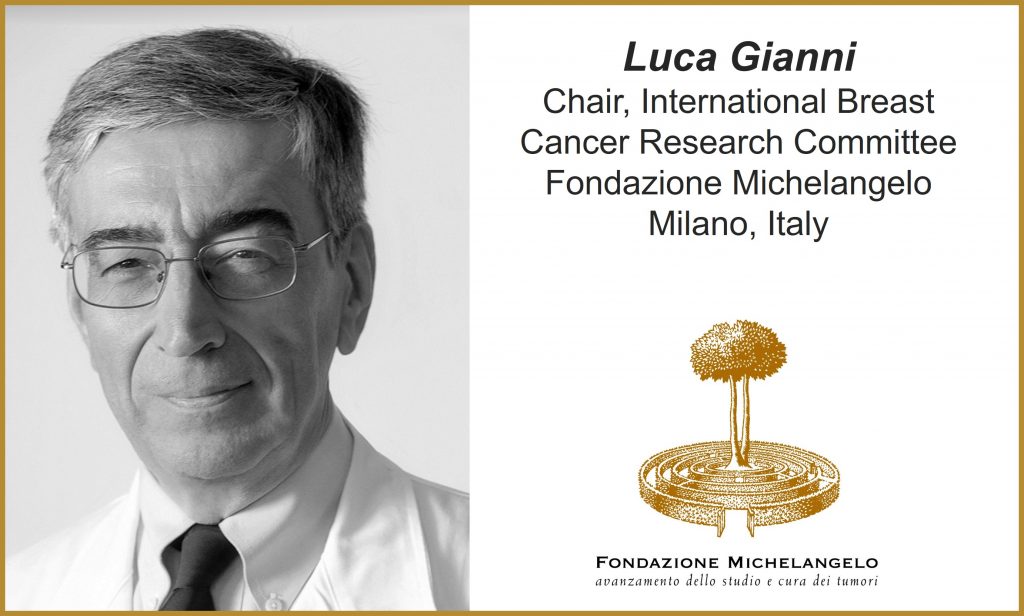New data from APTneo Michelangelo randomized trial, recently presented at the San Antonio Breast Cancer Symposium, suggests that adding atezolizumab to neoadjuvant anthracycline and cyclophosphamide (AC) followed by trastuzumab and pertuzumab plus chemotherapy (HPCT) increases the rate of pathologic complete response compared to HPCT and atezolizumab in operable high-risk early and locally advanced HER2+ breast cancer patients.
APTneo trial is a multicenter open label phase III trial led by Michelangelo Foundation, aimed to test the role of adding atezolizumab to neoadjuvant dual targeting of HER2 with trastuzumab and pertuzumab plus chemotherapy, and the value of also using anthracyclines in this setting. 661 patients with high-risk early or locally advanced HER2+ breast cancer were randomized to neoadjuvant HPCT without or with atezolizumab (Arm A and B, respectively); patients in Arm B were randomized to receive anthracycline and cyclophosphamide (AC) + atezolizumab followed by HPCT + atezolizumab (Arm 1), or to receive HPCT and atezolizumab (Arm B2). After surgery patients continued adjuvant HER2 directed therapies with or without atezolizumab until completion of 1 year; primary endpoint is event-free survival 5 years after randomization of the last patient, but a key secondary endpoint is the rate of pathologic complete response (pCR, defined as absence of invasive cells in breast and lymph nodes) with and without atezolizumab. Results show no significant difference in pCR between Arm A and Arm B and between Arm B1 and Arm B2, whereas Arm B1 had a 9.9% significantly higher pCR rate compared to Arm A, , regardless of hormonal receptor and PD-L1 status. Atezolizumab did not cause major tolerability issues. «This result may depend from the effect of anthracyclines themselves or drug-drug enhancement of anthracyclines and immune modulation», authors explain. Patients will continue to be followed up for event-free survival and overall survival analyses.

New data from APTneo Michelangelo randomized trial, recently presented at the San Antonio Breast Cancer Symposium, suggests that adding atezolizumab to neoadjuvant anthracycline and cyclophosphamide (AC) followed by trastuzumab and pertuzumab plus chemotherapy (HPCT) increases the rate of pathologic complete response compared to HPCT and atezolizumab in operable high-risk early and locally advanced HER2+ breast cancer patients.
APTneo trial is a multicenter open label phase III trial led by Michelangelo Foundation, aimed to test the role of adding atezolizumab to neoadjuvant dual targeting of HER2 with trastuzumab and pertuzumab plus chemotherapy, and the value of also using anthracyclines in this setting. 661 patients with high-risk early or locally advanced HER2+ breast cancer were randomized to neoadjuvant HPCT without or with atezolizumab (Arm A and B, respectively); patients in Arm B were randomized to receive anthracycline and cyclophosphamide (AC) + atezolizumab followed by HPCT + atezolizumab (Arm 1), or to receive HPCT and atezolizumab (Arm B2). After surgery patients continued adjuvant HER2 directed therapies with or without atezolizumab until completion of 1 year; primary endpoint is event-free survival 5 years after randomization of the last patient, but a key secondary endpoint is the rate of pathologic complete response (pCR, defined as absence of invasive cells in breast and lymph nodes) with and without atezolizumab. Results show no significant difference in pCR between Arm A and Arm B and between Arm B1 and Arm B2, whereas Arm B1 had a 9.9% significantly higher pCR rate compared to Arm A, , regardless of hormonal receptor and PD-L1 status. Atezolizumab did not cause major tolerability issues. «This result may depend from the effect of anthracyclines themselves or drug-drug enhancement of anthracyclines and immune modulation», authors explain. Patients will continue to be followed up for event-free survival and overall survival analyses.